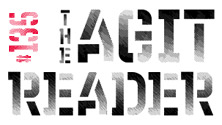
BB King’s, New York, February 17
by Stephen Slaybaugh
The only thing that could have made the Church’s performance last Thursday night at BB King’s any more surreal was if the club’s chubby namesake himself had come out and sung a few bars of “nothin’ don’t munch like Fritos do” before introducing the Australian band. As it was, that role was filled by the once-chunky and now slimmed-down Matt Pinfield, who didn’t do any singing, but was a strange sight to behold nonetheless. The dinner-theater setting of the club, which mostly hosts bands that jumped the shark ages ago like Uriah Heep and Vanilla Fudge, as well as a weekly Beatles brunch, seemed an odd setting to find the band performing three albums in their entirety, though perhaps they figured the audience would need the sustenance of nachos and buffalo wings to make it through the three-plus hour affair.
Further adding to the funhouse feel was the videos projected to either side of the stage while the band was performing. When not showing the band on stage, it seemed as if random images had been pulled from the internet—an Escher painting, a photo of a Juicy Couture storefront, a picture of a wooden cube, what looked like a teenager’s doodled notebook—and then run through some shareware to make them distort and swirl.
Fortunately, the band surpassed the cut-rate special effects and the Times Square venue’s tourist-ready set-up. They began the evening with their most recent effort, 2009’s Untitled #23, easily the band’s best record of the past decade or so. The record provided many highlights of the night, such as the shimmery tones of “Deadman’s Hand” and “Pangaea.” The Church core was in constant flux for most of the set, with Steven Kilbey, Marty Willson-Piper and Peter Koppes trading between various guitars and bass. Kilbey, whose predominant role with the band has been as bass player (as well as lead singer), managed to get out from behind his instrument several times through out the night. Doing so, however, only added to the weirdness of the night as he pantomimed and made strange interpretive gestures during such songs as “On Angel Street.”
Following a brief intermission, the band returned to perform Priest=Aura, their full-length from 1992. Never a commercial hit, the album nonetheless showed the band stretching out the dreamy pop that had for so long been their forte into expansive explorations of texture and mood. Live, though, it was the shorter cuts like “Ripple” and “Feel” that fared best. Still, in retrospect, the performance lagged in the middle.
After another break, the band returned for what most of the middle-aged crowd had been waiting, their 1988 commercial breakthrough, Starfish. Surprisingly, the big hit, “Under the Milky Way,” was the weakest of the bunch, seemingly rushed by off-pace drumming. “Destination” and “Antenna,” while not as forceful as I’d seen in years past (i.e. some 20 years ago), retained their magic. “Spark,” Willson-Piper’s lone turn at the mic, was less so, but the Koppes-sung “A New Season” fared better. As they closed with “Hotel Womb,” the disparity between the mystique their music once held and the setting where it had been played on this night was still unsettling, but if I closed my eyes, for a few moments I could still glimpse that gilded realm.
The Dismemberment Plan Live Review
Complaints Choir
Gruff Rhys Live Review
Todd P Goes to Austin
Guided By Voices Live Review
Hüsker Dü: The Story of the Noise-Pop Pioneers Who Launched Modern Rock
Bob Marley and the Golden Age of Reggae 1975-1976
A Dead Boy's Tale from the Front Lines of Punk Rock
Roky Erickson Live Review
Joy Division
Moogfest 2010
The Boombox Project
Bad Religion Live Review
Mozipedia: The Encyclopedia of Morrissey and the Smiths
